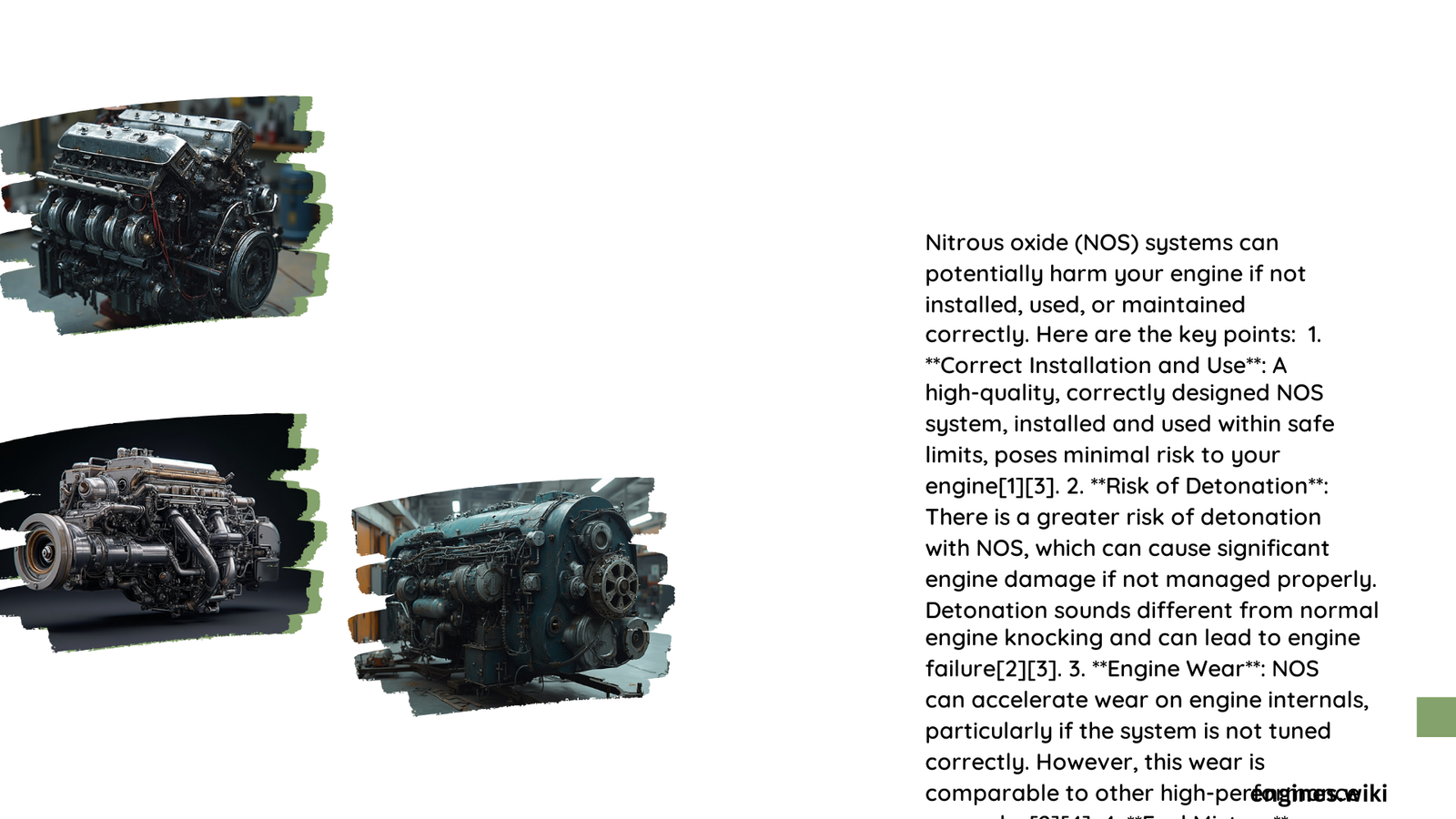Nitrous oxide systems (NOS) can potentially harm your engine if not used correctly. While NOS can significantly boost engine performance, it also increases cylinder pressures and temperatures, risking detonation, pre-ignition, and component stress. Proper installation, careful usage, and engine modifications are crucial to minimize damage. This article explores the mechanisms of potential harm, quantifiable effects on engine longevity, and necessary precautions when using NOS.
How Does NOS Affect Engine Components?
Nitrous oxide systems can impact various engine components in several ways:
-
Increased Cylinder Pressures: NOS introduces more oxygen into the combustion chamber, allowing for more fuel to be burned. This results in higher cylinder pressures, which can strain engine components.
-
Elevated Temperatures: The increased combustion leads to higher temperatures, potentially causing damage to pistons, connecting rods, and other critical parts.
-
Risk of Detonation: The extra oxygen from NOS can lead to detonation or pre-ignition, where fuel ignites prematurely in the combustion cycle.
-
Uneven Fuel Distribution: In some engines, NOS can cause uneven distribution of the nitrous/fuel mixture, leading to lean conditions in some cylinders and rich conditions in others.
-
Stress on Rotating Assembly: The increased power output places additional stress on the engine’s rotating assembly, including pistons, connecting rods, and crankshaft.
What Are the Quantifiable Effects on Engine Longevity?

While specific statistical data on failure rates due to NOS use is limited, several factors influence engine longevity:
- Engine Condition: Engines in poor condition or lacking necessary modifications are more susceptible to damage from NOS use.
- Frequency of Use: Overuse or prolonged activation of the NOS system can significantly increase the risk of engine damage.
- Proper Installation: Correct installation and usage within safe limits are crucial for minimizing damage risks.
How Does NOS Impact Engine Wear Metrics?
The use of NOS can accelerate wear and tear on engine components:
- General Wear: Increased stress on engine parts can lead to faster degradation.
- Catalytic Converter Damage: Incomplete fuel combustion can harm the catalytic converter.
- Transmission Stress: Additional power and torque can increase wear on the clutch and gearbox.
What Are the Performance Risks Associated with NOS?
Using NOS comes with several performance risks:
- Detonation: Running lean mixtures or advancing ignition timing can lead to detonation and severe engine damage.
- Component Failure: Without proper modifications, engine components may fail under the increased stress.
- Inconsistent Performance: Improper setup can result in inconsistent power delivery and potential engine damage.
What Modifications Are Required for Safe NOS Use?
To safely use NOS, several modifications may be necessary:
- Strengthened Engine Components: Upgrade pistons, connecting rods, and crankshaft to handle increased power.
- Fuel System Upgrades: Ensure accurate and adequate fuel delivery to match the increased oxygen from NOS.
- Ignition System Improvements: Upgrade spark plugs and ignition system to handle higher temperatures and pressures.
- Engine Management System: Install or upgrade to a system capable of managing the additional fuel and timing requirements.
How Can You Minimize NOS-Related Engine Damage?
To reduce the risk of engine damage when using NOS:
- Use conservative ignition timing
- Ensure a rich air/fuel mixture
- Limit NOS activation to short durations (10-15 seconds maximum)
- Regularly inspect and maintain all NOS-related components
- Use high-quality fuel and oil
- Monitor engine temperatures and pressures closely
What Are the Cost Implications of NOS-Related Engine Damage?
The potential costs associated with NOS-related engine damage can be significant:
- Engine Repairs: Damaged pistons, connecting rods, or cylinder heads can be expensive to replace.
- Engine Replacement: In severe cases, a complete engine replacement may be necessary.
- Preventative Upgrades: The cost of properly upgrading an engine for NOS use can be substantial but is often less than potential repair costs.
| Component | Potential Damage | Estimated Repair Cost |
|---|---|---|
| Pistons | Melting, cracking | $1,000 – $3,000 |
| Connecting Rods | Bending, breaking | $1,500 – $4,000 |
| Cylinder Heads | Warping, cracking | $2,000 – $5,000 |
| Engine Block | Cracking | $5,000 – $10,000+ |
Note: Costs are estimates and can vary widely based on the specific engine and extent of damage.
In conclusion, while NOS can significantly boost engine performance, it does come with risks of engine damage if not used properly. Careful consideration, proper installation, and appropriate engine modifications are essential to minimize these risks and enjoy the benefits of NOS safely.
References:
1. Tuner University: What’s So Wrong With Nitrous?
2. Wikipedia: Nitrous oxide engine
3. Indy Auto Man: What is a NOS Car? Pros and Cons of nitrous
